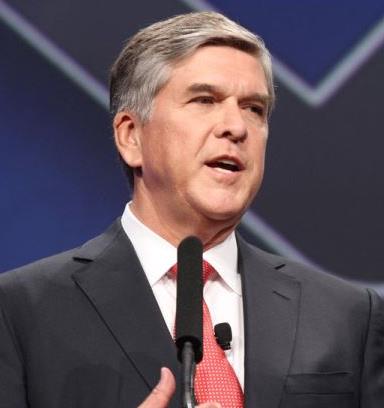
LAS VEGAS – While Gordon Smith, the president and CEO of the National Association of Broadcasters, opened the 2013 NAB Show pushing an innovation agenda, urging his member broadcasters to explore new technology, and innovate any way they can because the future of over-the-air broadcasting has never been brighter, comments from one of his primary members later in the morning seemed to be at odds with Smith’s assertions.
“Our future lies in innovating and spurring technology that will deliver our highly valued content to any platform for generations to come,” said Smith in his opening keynote. “The time has come for us to unite in our embrace of new technology and to realize the consequences if we don't.
For television, our future lies in our willingness to embrace new platforms, and to go where our viewers want to go. Emerging technology presents a great opportunity for broadcasters to provide viewers with our highly valued content anywhere, on any device, anytime they want it. For example, many stations that have embraced mobile TV are delivering broadcast television signals to consumers wherever they are – in their homes, cars or at a baseball game.”
American consumers can purchase receivers to attach to their tablets or phones to turn the device into a mobile TV screen, which receives the free, linear digital broadcast from participating broadcasters. Click here for more on the Dyle Mobile Content Venture, a partnership of a wide range of U.S. broadcasters, including the likes of Fox and NBC. It’s a neat and easy way to take TV on the go.

“Our one-to-many architecture allows us to deliver a product where there is no streaming necessary, so there's no signal congestion,” added Smith (right). “Our competitors in the wireless industry want to be part of the mobile TV business… and they are investing a lot of money in this endeavor. They are even branding their service ‘mobile TV.’ But our competitors will never have what we have – the ability to deliver our high-quality content reliably. As consumers' appetite for local TV on-the-go continues to grow, broadcasters must continue to rise up to meet consumers' desire for more live, local TV content.”
(Ed note: Of course, one wonders if mobile TV in this form will ever make it to Canada since the owners of two of the three national broadcasters are wireless companies trying their best to sell mobile video and not give it away for free. There is currently little exploration of this technology in Canada, other than through the CBC and Ryerson University.)
After Smith’s speech though, he sat down for a conversation on stage with Chase Carey, president and CEO of Fox parent company News Corp. The discussion turned to Barry Diller’s Aereo, a new technology which, for $8 month, users can view local TV stations via the internet. Aereo has perfected a technology making the rabbit ears for their customers about the size of a quarter and storing thousands of them remotely, so they can receive and deliver the signal to their subscribers, anywhere they are. So far, it’s only available to New Yorkers and Aereo pays no retransmission or wholesale fee to any of the broadcasters.
The American broadcasters are furious and have launched legal challenges but recently lost its first couple of rounds to Aereo where judges have denied the broadcasters an injunction against the new company. The decision held that transmissions made by consumers using Aereo are not public performances under the Copyright Act. Basically, the court ruled that using Aereo is the same as using your home rabbit ears.
Saying “Aereo is stealing,” its TV signal, Carey told delegates broadcasters will not be backing down on this fight and intend to continue its court fights, “and we believe we’ll prevail.” However, if they don’t convince the courts, or Congress, to do something to protect them “we will pursue other business solutions,” he added. “One such solution would be to take the network and turn it into a subscription service.”
Which seemed to us to be at odds with Smith’s assertion that broadcasters need to be distributed everywhere and that they are embracing mobile TV as a new business. If mobile TV is to be a viable business, the signals need to stay over-the-air, not direct-distributed to subscription TV carriers.

News Corp. released a more official statement after Carey (left) appeared on the NAB stage, which said: “We are committed to broadcasting under a business model where programmers receive fair compensation from parties that want to redistribute our product while continuing to make our product available for free to individual consumers that want to access our signal.
“We believe that Aereo is pirating our broadcast signal. We will continue to aggressively pursue our rights in the courts, as well as pursue all relevant political avenues, and we believe we will prevail.
“That said, we won’t just sit idle and allow our content to be actively stolen. It is clear that the broadcast business needs a dual revenue stream from both ad and subscription to be viable. We simply cannot provide the type of quality sports, news, and entertainment content that we do from an ad supported only business model. We have no choice but to develop business solutions that ensure we continue to remain in the driver’s seat of our own destiny. One option could be converting the Fox broadcast network to a pay channel, which we would do in collaboration with both our content partners and affiliates.”
A broadcaster saying a dual revenue stream is required… Where have we heard that before?
Photos courtesy NAB



